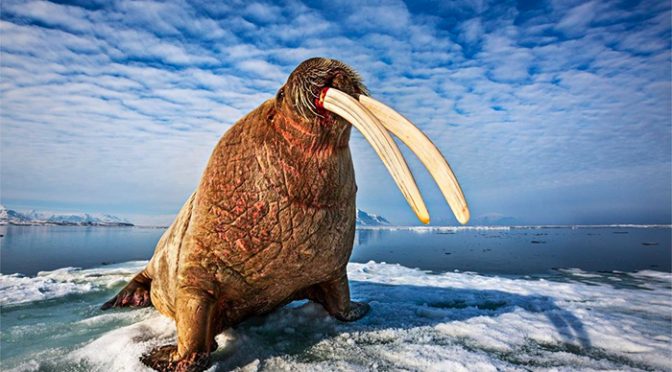
Eyck Freymann: How to Break China’s Minerals Chokehold
Why the allies need a multilateral commercial stockpile This essay is based on a Hoover History Lab working paper, co-authored with Joshua Stinson, William Norris,…
Thought Leader: Eyck Freymann

If you follow me on social media, you will not be surprised to find out that walruses are one of my favorite animals on this great Earth. They have Intelligence beyond comparison in pinnipeds and are survivors of an unimaginably icy world. They are highly social and display a gentle, serene temperament to go with their beauty. Having seen more than 50,000 walruses in the wild in Norway, Greenland, Canada and Alaska, it is safe to say that I love walruses.
Which brings me to beautiful Freya.
Life was going swimmingly for this young, female walrus from the Arctic.
Early this year, Freya left her native waters in the high Arctic and, after a circuitous route that took in coastlines along the Shetland Islands, Scotland, Northumberland, the Netherlands, Denmark and Sweden, she finally settled on the shoreline of Oslo Fjord, not far from Norway’s capital, this past July.
There, she delighted onlookers and Internet watchers alike with her playful antics, which included munching on mussels and clams and hauling her bulk onto small boats moored at the local dock, so she could bask in the midsummer Nordic sun.
This was unusual behavior, even for a walrus, as walruses tend to avoid human contact. Oslo Fjord is a busy summer playground as swimmers, kayakers, paddle-boarders and sightseers all try to take advantage of Norway’s all-too-brief break from winter.
Onlookers and behavioral scientists named Freya after the Norse goddess of love, beauty and fertility, who ruled over the mythical kingdom of Fólkvangr, a verdant valley where, it is said, the spirits of those who have died in battle go to rest.
Freya’s fame grew, boosted by a stream of video selfies on TikTok and Instagram, and it was only a matter of time before her antics went viral. Local fisheries officers issued a notice advising people to leave Freya alone. People were told to keep their distance, for their safety and hers.
The warnings were ignored.
And so, less than a month after Freya made her debut as an Internet star, the walrus who made a marathon swim from the Arctic to continental Europe was “euthanized” — the official word — on Sunday, August 14.

Walruses are an incredible species to work with. They are naturally intelligent, social and protective of their young.
I was saddened and angered, devastated even, when I heard that Freya had been killed in the prime of her life. I don’t know where to begin. In a lifetime of advocating on behalf of marine life and our urgent need to protect the sea, I have spent thousands of hours in the wild in the company of every species in the Arctic. Every animal is unique in its own way but, for me, the Atlantic walrus stands apart. I have found walruses to be by far the most charismatic, intelligent and interesting beings of all those I have engaged with during my years in the far north. I learned that, left alone, walruses can be surprisingly calm and curious around humans.
So when I say I love walruses, it is based on a lifetime of spending quality time with these remarkable animals in their natural home.
Freya was not the problem. People were the problem. And the incident goes a long way to shining a light on our treatment of wild animals and how we deal with them when they become an inconvenience.
Freya weighed 1,300 pounds (600 kg) and was judged to be about 10 years old. Sometimes, when she heaved her bulk up on a moored pleasure boat, the boat sank under her sheer weight. On July 31st, she was spotted filling up a boat with water so that she could use its bilge pump as a shower. The video went viral on Twitter.
There were no reports of her attacking people, but she was seen chasing a duck on one occasion, and she menaced a swan.
Freya was quite possibly a climate refugee. We invade their territory, causing sea ice to melt at an alarming rate. That drives walruses from their traditional foraging habitats, and they inevitably come into contact with humans while searching for a place to rest. She was doing no harm and would have moved on eventually. She was killed because she damaged a couple of boats.
Fisheries officials insist they considered alternative measures, including relocation, but decided it was too costly. So she was killed.
“I am firm that this was the right call,” Frank Bakke-Jensen, head of Norway’s Directorate of Fisheries, said in a prepared statement. “We have great regard for animal welfare, but human life and safety must take precedence.”

Walruses’ prehistoric, saber-like tusks may grow more than three feet during their lifetime. Walruses have an occasional and somewhat grumpy disposition.
In the big picture, the circumstances surrounding Freyaʼs death are becoming all too common. We humans are often bad at listening, and particularly bad at listening to officials warning us what to do and what not to do around wild animals. Social media is full of examples of people misbehaving around animals. Why doesn’t common sense prevail? Everyone who crowded a 1,300-pound walrus put themselves at risk and contributed to Freya’s tragic end. Freya was killed, not “euthanized,” since it was not to put Freya out of her misery or end her suffering.
Freya was a sentient being, trying to exist in a world made by humans, trying to live her life and be left alone, and for that, she was killed.
It did not have to end this way. It should not have ended this way. As stewards of this planet, we have a collective responsibility to do better.

Large walrus groups like this one travel long distances in search of clam beds, their primary food source. Walruses can grow to 2,200 pounds, so they need large quantities of mussels and clams to sustain them.
Have a friend who might enjoy Born Wild? Invite them to subscribe.
Eyck Freymann: How to Break China’s Minerals Chokehold
Why the allies need a multilateral commercial stockpile This essay is based on a Hoover History Lab working paper, co-authored with Joshua Stinson, William Norris,…
Thought Leader: Eyck Freymann
Chris Miller: Robotics Manufacturing: The Rise of Japan
“To the Americans, a robot is a computer attached to a mechanism. To Japanese, a robot is a mechanism attached to a computer.” The future…
Thought Leader: Chris Miller
Dr. Sanjay Gupta: A New Understanding of Parkinson’s Disease
Parkinson’s disease, a progressive movement disorder whose hallmark is damage to the dopamine-producing neurons in the brain, afflicts almost 12 million people worldwide. And the…
Thought Leader: Sanjay Gupta

